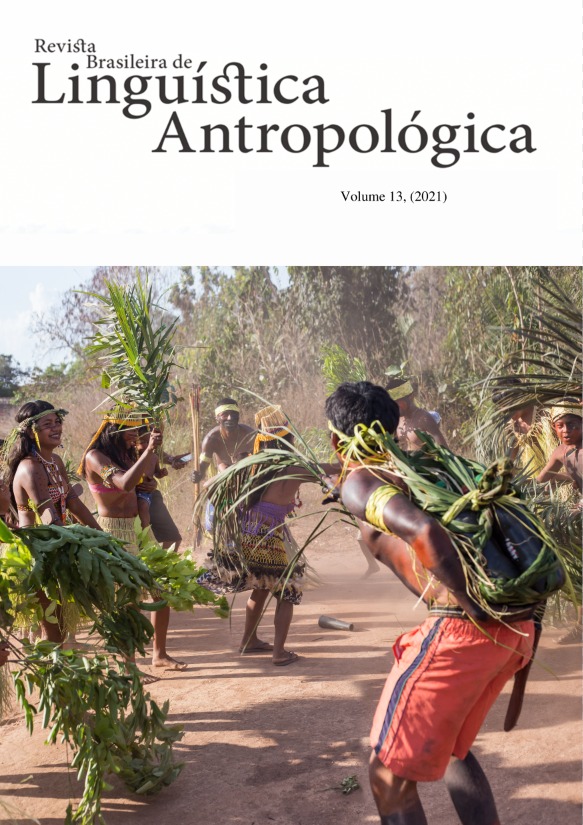Zootopônimos indígenas da região insular de Ananindeua-PA
DOI:
https://doi.org/10.26512/rbla.v13i01.38394Keywords:
Topônimos. Zootopônimo. Taxeonomia. Geossociolinguística. Ananindeua-PA.Abstract
This paper seeks to identify zootoponyms in the municipality of Ananindeua-Pará. The work integrates the geosciolinguistic dynamics (Razky, 1998) of the research axis Linguistic Atlas of Portuguese in Indigenous Areas (ALiPAI) of the Geosciolinguistics and Sociotherminology project coordinated by Abdelhak Razky (UnB / UFPa / CNPq). The present study aims atdocumenting and analyze the zootoponyms of the neighborhoods, communities, boreholes of rivers, rivers, islands and streams in the city of Ananindeua-PA, in order to classify them as to their taxonomy, according to the motivations toponymics proposed by Dick (1990a, 1990b), and their morphological structure. The data were organized in a table with the respective columns (toponym / geographical feature / etymology / morphological structure). The results reinforce the indigenous influence when analyzing the toponymic motivations of the zootoponyms (rivers, streams, river holes and islands), of the insular region of the referred municipality.
References
Bechara, Evanildo. 2011. Dicionário Escolar da Academia Brasileira de Letras: língua portuguesa. São Paulo: Companhia Editora Nacional.
Biderman, Maria Tereza Camargo. 2001. Teoria lingüística. Teoria lexical e lingüística computacional. São Paulo: Martins Fontes.
Candau, Joel. 2018. Memória e Identidade. São Paulo: Contexto.
Carvalho, Moacyr Ribeiro. 1987. Dicionário tupi (antigo) – português. Salvador: Empresa Gráfica da Bahia.
Costa, Albenizia; Assano, Miciko; Jansen, Tilcia. 2014. Atlas Básico do Município de Ananindeua. Belém: Marajoara.
Cunha, Antônio Geraldo. 1998. Dicionário histórico das palavras portuguesas de origem tupi. 4. ed. São Paulo: Companhia Melhoramentos; Brasília, DF: Universidade de Brasília.
Dargel, Ana Paula Tribesse Patrício; Ribeiro, Ana Lúcia. 2013. Toponímia: Teoria Geral e Análise Quantitativa dos Litotopônimos do Estado de Mato Grosso do Sul catalogados no Atems. Web Revista. Página de debates. 22. ed.
Dick, Maria Vicentina de Paula do Amaral. 1987. Toponímia e Antroponímia no Brasil. Coletânea de Estudos. FFLCH-USP. São Paulo.
Dick, Maria Vicentina de Paula do Amaral. 1990a. A motivação toponímica e a realidade brasileira. São Paulo: Arquivo do Estado de São Paulo.
Dick, Maria Vicentina de Paula do Amaral. 1990b. Toponímia e antroponímia no Brasil: coletânea de estudos. 2. ed. São Paulo, FFLCHH/USP.
Gregório, Irmão José. 1980. Contribuição Indígena ao Brasil. III vol. Belo Horizonte: União Brasileira de Educação e Ensino.
Isquerdo, Aparecida Negri. 2008. O nome do município. um estudo etnolinguístico e sócio-histórico na toponímia sul-mato-grossense. Prolíngua, v. 2, n. 2, 11.
Isquerdo, Aparecida Negri. 2012. A Motivação na toponímia: algumas reflexões. In Sella, Aparecida Feola; Corbari, Clarice Cristina; Bidarra, Jorge (org.). Pesquisas sobre léxico: reflexões teóricas e aplicação. Campinas, SP: Pontes Editora.
Mendes, Gisele Alves. 2003. Ananindeua: dos trilhos ao asfalto. Edição do Autor, Ananindeua.
Mendes, Raimunda Lopes R. 2016. Educação ribeirinha: paradigmas, diversidade e saberes – Ilha de João Pilatos – Escola Domiciano de Farias. Ananindeua: Edição do autor.
Navarro, Eduardo de Almeida. 2013. Tupi antigo: A língua indígena clássica do Brasil. São Paulo: Global.
Oliveira, KJS. 2020. Estudo Toponímico no Município de Ananindeua-Pará. Dissertação de Mestrado. Universidade Federal do Pará.
Sampaio, Teodoro. 1987. O tupi na geografia nacional. 5. ed. São Paulo: Nacional.
Souza, Márcio. 2009. História da Amazônia. Manaus: Editora Valer.
Tibiriçá, Luiz Caldas. 1985. Dicionário de Topônimos Brasileiros de Origem Tupi. São Paulo: Editora Traço.
Downloads
Published
Issue
Section
License
Copyright (c) 2021 Revista Brasileira de Linguística Antropológica

This work is licensed under a Creative Commons Attribution 4.0 International License.
Authors who publish in RBLA agree to the following terms:
a) Authors maintain the copyright and grant the journal the right of first publication, and the work is simultaneously licensed under the Creative Commons Attribution License, which allows the sharing of the work with recognition of the authorship of the work and initial publication in this journal.
b) Authors are authorized to assume additional contracts separately, for non-exclusive distribution of the version of the work published in this journal (eg, publish in an institutional repository or as a book chapter), with recognition of authorship and initial publication in this journal.
c) Authors are allowed and encouraged to publish their work online (eg, in institutional repositories or on their personal page) at any point before or during the editorial process, as this can generate productive changes, as well as increase impact and citation of the published work.










